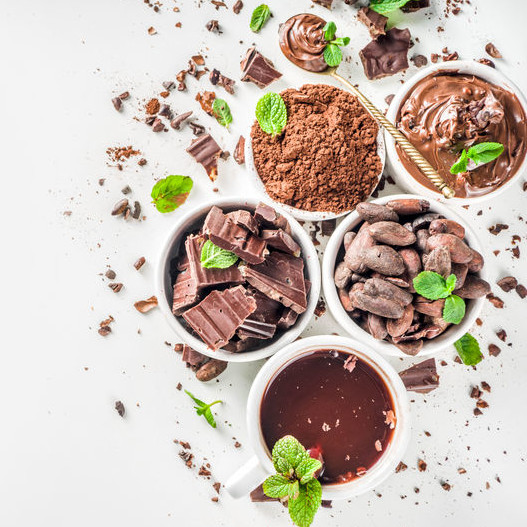
Chocolate Liquor
Also Known as Cocoa Liquor
What is Chocolate Liquor?
Chocolate liquor is a paste produced from ground cocoa nibs from the beans of the cocoa tree (Theobroma cacao).
When cooled and solidified, it is used to make chocolate for baking, confections and other applications.
- It is a primary product of the chocolate manufacturing process
- It’s composed of a combination of cocoa solids and cocoa butter, typically at a 50:50 ratio.
Origin
The name ‘liquor’ in this ingredient indicates an ancient reference to a ‘liquid’ or ‘fluid’ but not to an alcoholic or distilled material. Chocolate liquor is produced from cocoa beans and is the base substance from which chocolate is made. Most commercially available cocoa beans used in making cocoa liquor come from Mexico, Venezuela, Ecuador, West Indies and African west coast.
Function
Chocolate liquor provides bakers with various benefits such as:
- Unique flavors: cocoa and chocolate products contain over 1500 flavor compounds including those associated with Maillard reactions.
- Oxidation resistant low melting point cocoa butter
- Unique structure and desirable color
- Presence of high levels of flavonoids and other beneficial antioxidants
Commercial production
Cocoa beans are processed through the following steps:
- Fermentation
- Drying
- Roasting
- Removing skins
- Grounding into cocoa mass/paste
- Melting to liquor
- Separating liquor to cocoa solids and cocoa butter
- Cooling and molding into blocks of raw unsweetened baking chocolate
Various grades of chocolates such as dark, semi-sweet, milk chocolate and others can be made from chocolate liquor by adding sugar, soy lecithin, cocoa butter, etc.
Composition and Nutrition
Chocolate liquor nutrient per 100 g:1
| Fat | 53 g |
| Carbohydrate | 27 g |
| Fiber | 18 g |
| Protein | 11 g |
| Calcium | 80 mg |
| Iron | 5.6 mg |
| Sodium | 5 mg |
Cocoa-liquor is rich in polyphenols such as tannins, catechins, theobromine and other flavonoids, known for their antioxidative properties. In addition, they can also play a major role in improving vascular health, by reducing blood pressure, improving blood flow and reducing the risk of cardiovascular diseases.
Application
Chocolate liquor can be used directly as baking or bittersweet chocolate. Or, it can be separated into constituent parts of cocoa powder and cocoa butter. The proportion of chocolate solids to cocoa butter can vary with the specific application or desired flavor profile. However, the FDA specifies the fat content of chocolate liquor to be from 50% to 58%.2
Various forms of chocolate can be added to bakery formulations in the form of chunks or molten fluids or as a topical coating and decoration pieces. Cakes, cookies, brownies, croissants, danish and other baked goods made with chocolate are perceived as premium products by consumers.
Melting and flavor/bitterness release from chocolate liquor and its derivatives are mostly determined by the cocoa solids content. Formulating cakes and other baked goods with chocolate liquor may call for additional water or eggs to be added to the recipe.
Chocolate liquor is a dairy-free ingredient and is suitable for vegan diets.
FDA Regulations
Chocolate liquor, as a standardized cocoa product, is regulated by FDA under 21CFR163.111.3
References
- Chocolate liquor. https://www.eatthismuch.com/food/nutrition/chocolate-liquor,121450/. Last accessed by Jan 22.2020.
- What is Chocolate Liquor? Guide to Chocolate Liquor vs Chocolate Liqueur. https://respectthechocolate.com/chocolate-liquor/. Last accessed by Jan 22. 2020.
- CFR – Code of Federal Regulations Title 21CFR163.111. Accessdata. Fda. gov. April 01.2019. https://www.accessdata.fda.gov/scripts/cdrh/cfdocs/cfcfr/CFRSearch.cfm?fr=163.111. Last accessed Jan 22. 2020.

